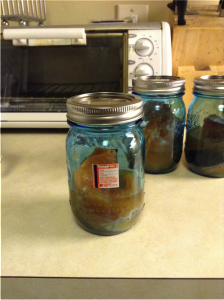The kitchen sponge has been gaining a lot of traction lately in food safety media that stemmed from the recent German study that analyzed 14 sponges. Don Schaffner provided his expertise regarding the validity of the study on Barfblog earlier.
It is no surprise that sponges harbor bacteria, what is surprising is all of the conflicting messaging on what to do with them. Food safety messaging needs to be rapid, reliable, relevant and repeated. Unfortunately it is not just food safety messaging on social media, inconsistency exists within food safety Regulations in Canada compounding the problem further. But that’s a whole other blog.
A study conducted in 2007 evaluated different disinfection methods to reduce bacteria, yeasts and molds on kitchen sponges (1). Sponges were soaked in 10% bleach solution for 3 min, lemon juice (pH 2.9) for 1 min, or deionized water for 1 min, placed in a microwave oven for 1 min at full power, or placed in a dishwasher for full wash and drying cycles, or left untreated (control). The study showed that microwaving or placing the sponge in a dishwasher significantly lowered aerobic bacterial counts on sponges more than chemicals and control.
Doug Williams of the The San Diego Union Tribune writes:
As a longtime food safety consultant, teacher and inspector, Robert Romaine has seen plenty of disastrous and dirty commercial kitchens.
He knows the menacing microbes that make us sick and has seen the evils lurking in kitchen corners.
So, he has a couple of rules. One, avoid potlucks. Who knows how that chicken salad was prepared. And two, when invited to a friend’s house for dinner, put the blinders on.
“When I’m visiting someone, I try not to hang around the kitchen,” says Romaine, who owns Food Safety Consulting in San Diego. “Sometimes I know too much, and I just don’t want to know what’s going on in there.”
The dangers are many, from improper refrigeration to cross contamination. But recently, there’s been an added focus on kitchen sinks and counters and the way people keep them clean — or don’t.
Yet as Romaine notes, precautions can easily be taken in our home kitchens to lessen the dangers of contamination.
Take that disgusting sponge, for instance.
“If a person is careful and actually knows they got the sponge up to 180 degrees (when cleaning it), nothing’s going to live,” he says. The key is being certain the temperature is high enough, not just warm but lethally hot. Federal government guidelines suggest 165 degrees as the minimum temperature for killing bacteria. A food thermometer can be used to test that sponge after microwaving. Adds Joyce Wilkins, who taught food safety for years in San Diego through her business, Safe at the Plate: “Yes, the sponge is fairly disgusting. All bacteria, all organisms die at 165 degrees, so if you heat it up hot enough to burn you in the microwave, you will kill it.”
Wilkins, in fact, discourages the use of a sponge and suggests buying a pack of 10 dishcloths instead and using a fresh one every 24 hours. “The big issue is dampness,” she says. “Bacteria need water to survive, and if the cloth is dried out each time,” it helps prevent bacteria growth.
Romaine suggests using paper towels instead of cloths or a sponge for cleanup, especially after preparing meat or chicken. Paper towels can be thrown away so bacteria can’t be transferred. “Obviously, if you just cut up raw chicken, you don’t want to use a household sponge for that,” he says. “But if you’re just wiping up debris from cutting up bread or vegetables, that’s not very harmful.”
Wilkins also will use isopropyl alcohol to clean surfaces, along with a stiff-bristled brush instead of a sponge. A cutting board used to prepare chicken, for instance, will be scrubbed with a brush and hot, soapy water, then treated with some of the alcohol to kill remaining germs, rinsed and allowed to air dry. The same system can be used for countertops, where a brush can dislodge the bio film that can build up over time (and not be rubbed away with a sponge or cloth).
Instead of using a dishtowel to dry just-washed plates and utensils — a towel that may have been used to dry hands or wipe a countertop — allow those plates and utensils to air dry.
Do not use isopropyl alcohol to clean surfaces, washing with soap and water applying friction is good enough.
1. Manan Sharma , Janet Eastridge, Cheryl Mudd. 2007. Effective household disinfection methods of kitchen sponges. Food Control 20 (2009) 310–313
 However, one mum – who is tired of buying new toilet brushes every few months – has come up with a controversial idea to keep her toilet brush clean – and it’s certainly divided certain circles on the Internet.
However, one mum – who is tired of buying new toilet brushes every few months – has come up with a controversial idea to keep her toilet brush clean – and it’s certainly divided certain circles on the Internet.






